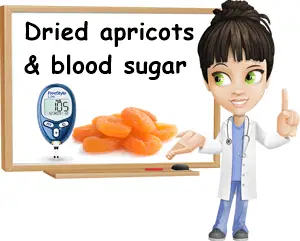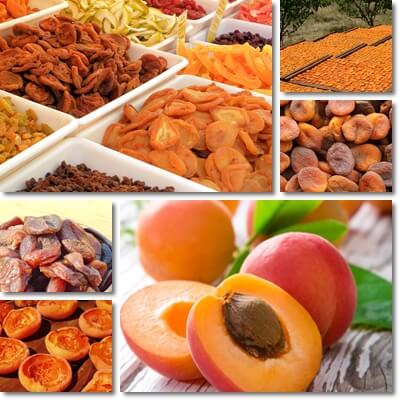Dried apricots are one of the best dry fruits for diabetes type 2 and type 1 because of their low glycemic index. A low glycemic index value means that effects on blood sugar metabolism are minimal so there won’t be any significant rises in blood sugar levels. So long as intake is limited to small servings of maximum 6 halves or 30 g and the apricots are unsweetened. The only thing that can offset the benefits of a low glycemic index is eating too much of the dried fruit at once. By sticking to small amounts, diabetics may continue to enjoy dried apricots and all the benefits they provide for their condition.
What is the glycemic index? The glycemic index (GI) is a scale that measures how fast the carbohydrates in a food raise blood sugar levels, also known as blood glucose levels (glucose being a type of simple sugar and the main sugar circulating into the bloodstream). Below 55 is a low GI. Between 55-69 is a moderate GI. Between 70-100 is a high GI. The lower the GI of a food, the lesser its effects on blood sugar and the better it is for diabetes.

Low GI foods release sugar into the bloodstream more slowly, resulting in a steadier increase in blood sugar levels. Whereas high GI foods release sugar more rapidly into the bloodstream, rising levels quickly and overwhelming the diabetic patient’s metabolism. Many fresh fruits have low glycemic index values, but a lot of dried fruits have moderate to high glycemic index values. Except dried apricots.
Dried apricots glycemic index: 30, 30+ (low)
Dried apricots glycemic index is estimated at 30 (sometimes 30+), which is low. The glycemic index of dried apricots is actually lower than that of pears (38), apples (39), plums (40), fresh figs (35-40), strawberries (40), grapes (45-53, depending on variety), pomegranate (below 55), bananas (42-62), pineapple (66) and watermelon (72). So eating a small serving is likely just as good as eating a serving of fresh fruit with a low glycemic index and better than eating fruit with high glycemic index values.
However, know that a serving of dried fruit like apricots is a lot smaller compared to a serving of fresh fruit. For example, a serving of dried apricots may consist of as little as 3 dried fruit or 6 halves, whereas a serving of fresh fruit may include a whole fruit such a whole, medium-sized apple or a small banana or 10+ grapes.

Also, make sure you check the apricots have not not been sweetened, which is unlikely, but possible. The high GI values of many commercially produced dried fruit are owed to them being sweetened (such as in the case of cranberries which are naturally sour and thus not very palatable). But dried apricots have a naturally pleasant taste and don’t require sweetening which contributes to their low glycemic index and reduced effects on blood sugar. In any case, it’s best to always read the label of the product to see if any sweeteners have been added and choose only unsweetened apricots.
What makes dried apricots low glycemic foods?
Several factors and nutritional properties contribute to their positive effects on blood glucose metabolism and benefits for insulin control:
1) Eating small servings. The smaller the serving, the smaller the intake of carbohydrates and the lesser the glycemic effects.
2) Good fiber content. Dietary fiber is indigestible plant material. It slows down the digestion process and the rate of sugar absorption into the bloodstream, contributing to a steadier increase in blood sugar levels and a low glycemic index. A serving of of 30-40 g provides up to 3 g of dietary fiber.
3) Tough, chewy texture. Makes digestion lengthier and contributes to lower glycemic index values.
4) Lack of added sweeteners. Unsweetened dried apricots are low glycemic.
5) Higher fructose content. Studies say fructose (a simple sugar found naturally in fruit) contributes to better insulin control and reduces blood glucose levels in type 2 diabetes patients.
6) Minor hypoglycemic effects from antioxidants (carotenoids, anthocyanins, procyanidins and others), vitamins such as vitamin E and other elements with antioxidant properties. In addition to minor hypoglycemic effects, elements like these favor better insulin responses and insulin production.
How many dried apricots in a serving for diabetes?
Dried apricots serving size best not exceeds 6-8 halves (the equivalent of eating 3-4 fresh apricots) or about 30 g. Two halves will get you the nutritional equivalent of 1 fresh fruit in terms of carbohydrate, sugar and fiber content. So even though 6-8 halves may not seem much, they do contain plenty of carbs, just in concentrated form. Know that eating too many dried apricots at once cancels out the benefits of a low glycemic index by providing an excess of carbohydrates which is why diabetics are advised to limit their intake to small servings.
Ideally, all diabetics should see their doctor or a dietitian with experience in diabetic diets and receive a personalized eating plan that includes recommendations for maximum carbohydrate intakes per day and per meal. This should help with meal planning and allow for the safe consumption of small amounts of dried fruit.
So do dried apricots raise or lower blood sugar?
The answer is both. Because they contain carbohydrates mostly in the form of simple sugars, dried apricots will contribute to blood sugar levels. But because of their low glycemic index (chewy texture, fiber content), the sugar from the carbohydrates is absorbed at a steadier rate and increases blood sugar levels more slowly, which is good for diabetes. So long as intake is limited to small servings at once, preferably no greater than 30 g or 6-8 halves of the dried fruit.
At the same time, the gummy texture, higher fructose content and properties of various antioxidants and other elements in the dried fruit exert minor hypoglycemic effects as well as stimulate insulin production, improve insulin response and blood glucose control. All of this holds benefits for type 2 diabetes in particular. So you can say that, in a way, dried apricots have the potential to both raise and lower blood sugar, although the lowering blood sugar part may yield less visible effects.
